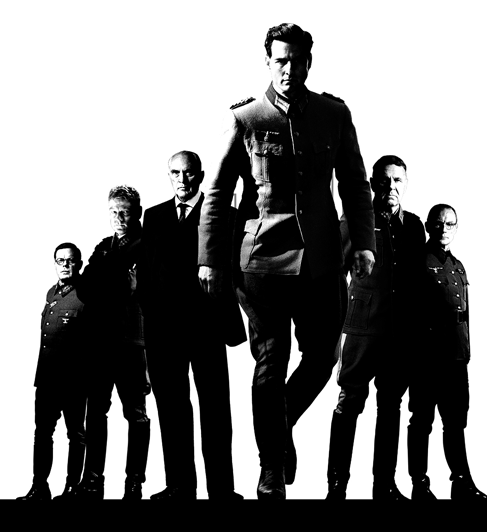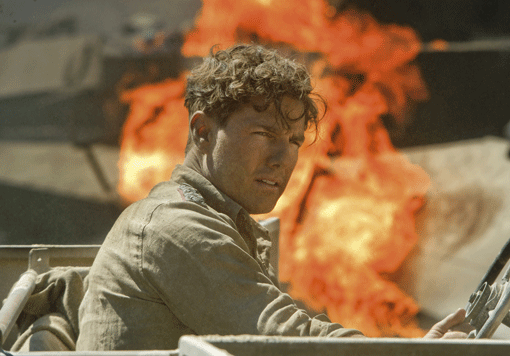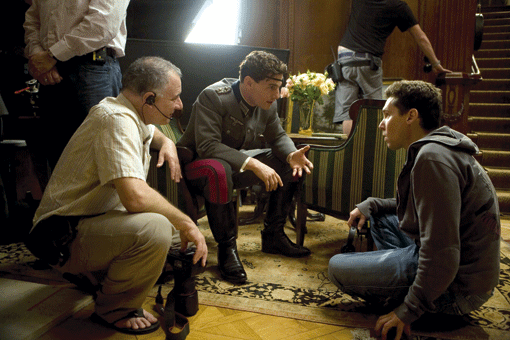
Cinema

Tom Cruise and Bryan Singer
on ‘Valkyrie’
The Good Germans Make Good
By: Jenni Miller *
Apparently Tom Cruise is no longer washed up.
Cruise plays Col. Claus von Stauffenberg, the officer who spearheaded the plot and died as a result of its failure. He had not been familiar with the story before reading the script, he admits.
“When I read the script, I thought it was incredibly suspenseful, a great thriller,” Cruise says. “When I put it down, I thought, ‘This can’t be true.’ Then I met with Bryan, and I always wanted to work with him. I had seen ‘Usual Suspects’ (1994), and we met at the premiere of ‘Mission: Impossible’ (1996), the first one, and I said, ‘Man, I want to work with you.’
“He explained that this is a true story,” he says. “It’s a great story, so off we went.”
It wasn’t enough that it be historically accurate, however. Cruise, who also executive-produced the film through his studio United Artists, had been through some major career turmoil, and had a great deal riding on the film’s popularity at the box office.
“It’s an important story,” the actor says, “but I also felt that I wanted to entertain audiences. That was a bonus, really, for the film, but it’s something that Bryan and I have spoken about.
“It’s important to know that not everybody fell into that Nazi ideology,” Cruise says. “That to me was surprising. I grew up wanting to kill Nazis, wanting to kill Hitler. As a child I’d think, ‘Why didn’t someone just shoot him?’ And this is a massive and comprehensive story that could have been turned into a five-hour, 10-hour movie or miniseries. But Bryan was specific: This is a suspense thriller about killing Hitler.”
Singer emphasized the need for the movie to succeed as a movie, even for audience members who didn’t know or didn’t care that it was a true story.
“This is not a Holocaust movie,” Singer says. “It’s a conspiracy thriller about assassinating Hitler. As Tom was just saying, the bonus is that it happens to be true. It happens to be gripping, and even things that you might think are film conventions, Hollywood conventions that happen in the movie, twists and turns, actually did happen.”
Like Cruise, Singer needed a hit. He had scored with “X-Men” (2000) and its sequel, “X2: X-Men United” (2003), but the incredibly expensive “Superman Returns” (2006) had failed to meet its sky-high expectations. He especially need “Valkyrie” to succeed so that he wouldn’t be pigeonholed as a director of comic-book movies.
“If you’re at a point where you can -- as a director I could speak, not as an actor but as a director -- if you’re at a point where you can do what you want to do creatively,” Singer says, “then you’re successful, really successful. And that’s a blessing.”
“I agree with Bryan as far as making films,” Cruise says. “I just love movies. I’ve told people before, when I was making ‘Taps’ (1981) or ‘Risky Business’ (1983), there were moments where you think, ‘I just want to enjoy these moments, because I don’t know if it’s going to end right here.’
“There’s a certain moment where I had the opportunities to work with Paul Newman, to work with Dustin Hoffman and Gene Hackman and Scorsese and Oliver Stone and Spielberg and now Bryan Singer,” he continues. “The people I’ve been able to work with, the kind of creative freedom that I’ve been privileged enough to have ... “
That freedom might have been a thing of the past. Well before the film opened, there was talk that it was a flop, that test audiences were down on the movie, that it might mark the end of Cruise’s reign as Hollywood’s top star.
“I know that there’s been a few things written about this film before people have seen it,” Cruise says with a laugh. “Just a couple.”
“We read them all,” Singer says, joining in the laughter. “Out loud, to our folks.”
“There are so many times I’ve been through this,” Cruise says more seriously, “and certainly I think the Internet has accelerated a lot of this kind of drama out there. There’s a perception versus what we’re doing artistically, and even I think when people see the film, even our friends who have seen the film were like, ‘Oh! This is a suspense thriller!”’
Singer laughs.
“Like, what did you think we were making?” he chortles. “Soup?”
“Yeah, that’s what we kept saying,” Cruise says. “So many times in my career, even early on, people have said, ‘Why are you doing that?’ Even as early back as when I was going to do ‘Top Gun’ (1986) or ‘Born on the Fourth of July’ (1989), the things that Dustin and I went through on ‘Rain Man’ (1988) -- we went through four directors -- I’ve always chosen things that I felt would be challenging, but I’ve always wanted to entertain an audience, and I feel very privileged to do that.”
Some of the rumors about “Valkyrie” were natural, given that the movie’s projected February 2008 release was postponed several times, often the sign of a film in trouble.
“It was going to come out a lot earlier,” Singer concedes, “but then there was a sequence, the Tunisia sequence, that took time. I ended up scouting Jordan for a location, and then Spain, and those two locations didn’t work out, both aesthetically and economically.
“And then we figured we would just see what movie we had when we got home, cut it all together and then go back and go to California, where the location we found looks far more like Tunisia,” the director continues. “We would have the equipment and resources, and we would sort of drop and pick up. And that moved our intentions of release date, and then it was a crowded Christmas and we didn’t know where we were at finishing the movie ... “
“We were making a film, not a release date,” Cruise says. “I know today everything is about a release date. February was never a firm date. This is a film that’s made for a broader audience. We also never wanted to say, ‘Hey, we want to put it in awards season.’
“That’s not even why we moved to Christmas,” he says. “Christmas is a great time for audiences. It’s the biggest time of year for people to go.”
Those going to see “Valkyrie” aren’t seeing the Tom Cruise they’re used to seeing: Stauffenberg lost a hand and an eye earlier in the war, so for most of the film Cruise works one-handed and wears a large, black eye patch.
Initially, he says, the eye patch cost him his sense of balance.
“For a few hours and a few days, when we started working on it, it did,” Cruise says, “especially when it was dark. I lost depth perception and balance. And also, from visual, cinematic storytelling, it was a challenge for Bryan.
“When I look at his movies, they’re very cinematic with classic storytelling,” the actor says, “but it’s cool. He understands cinema storytelling, and with the eye patch he also understood that it’s a different story depending on where that camera is on my face. So different profiles, shooting with the patch and the hand was a challenge when setting which angle we shot.”
The issues were complex ones, Singer says.
“If you’re staging a scene on a set, and you really want to shoot out the set and make it look pretty and position the actors in relation to one another,” he explains, “but if this side’s one thing and this side’s the other thing, he can’t see the other actor, so that reverses where they are. That could end up reversing where the camera is in the room, which could end up reversing what part of the room we’re shooting in, so in the morning you’d have to work these things out in relation.
“Or something as simple as, ‘Yeah, you put your hand on his shoulder ... ‘ ‘What hand?’ ‘OK, you put your three fingers on the other hand ... ‘
“And although all that’s removed and done digitally,” Singer says, “Tom’s performance had to inform all of that, long before we got into the visual effects, and be cognizant of it.”
Singer already had his hands full recreating a period which was one of the first in history to have been informed, visually, by the power of movies. Nazi uniforms, pageantry and even architecture were all influenced by the way they would look on newsreel film.
“I studied a lot of war photography,” Singer recalls. “Hitler filmed everything, so we have the benefit of a lot of motion-picture film, both color and black-and-white, of that era. So it was important in recreating both the dimensions, which is why I shot 1.85 aspect ratio. In Germany we shot in color with Aeroflex cameras and the Zeiss lenses, so it would look like it did to people who lived back then, as opposed to approximate black-and-white to muddy or desaturate the film.
“In terms of the pageantry and the military aspects of it, we had those references, and we worked with the military advisers who knew the history and could help us with the movements and salutes.”
The time and expense was well worth it, Cruise says.
“The whole point is to try to give that audience that visceral feeling of being on the edge of their seat,” Cruise says. “The level of detail in the film from top to bottom, even down to Hitler’s signature -- when he signed, it was, to the best of our knowledge, exactly the signature that he signed at that time period. Same with Stauffenberg.
“I mean, this is the kind of stuff that we film-geeked and history-geeked out on, you know what I mean?”
* Jenni Miller is a senior editor for Premiere.com.